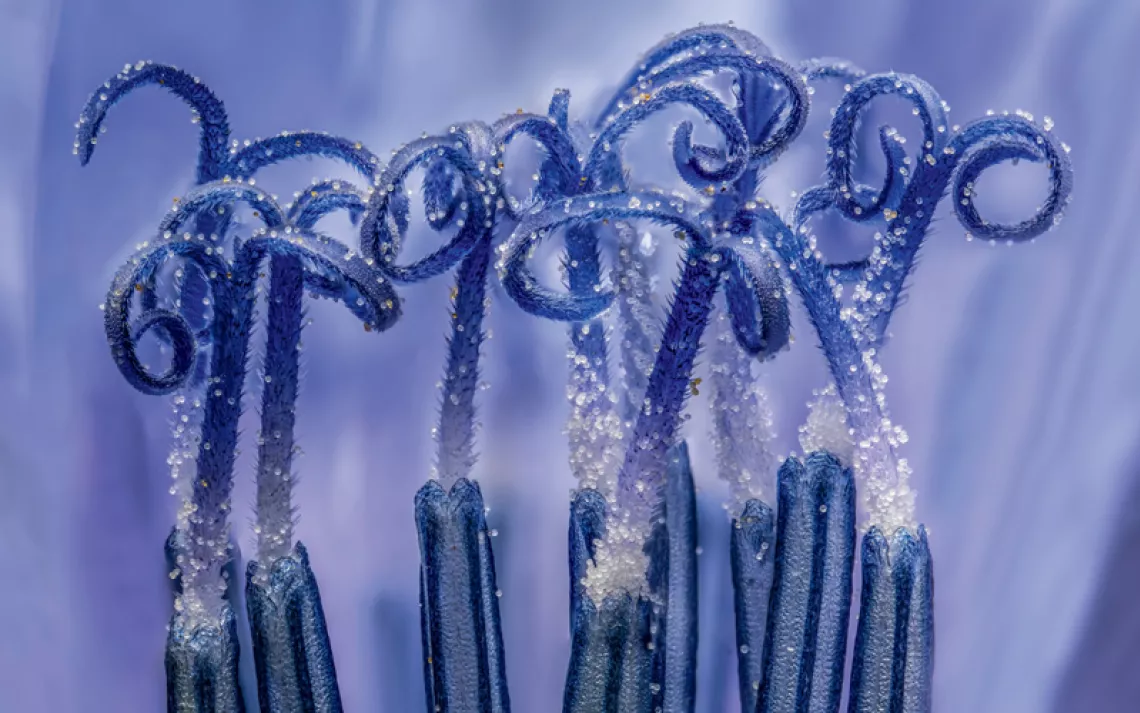Live Long and Fail to Prosper
How do you study a flower with an 80-year lifespan?

A field of Aspen sunflowers (Helianthella quinquenervis) at a study site in Colorado. | Photo courtesy of David Inouye
In 1974, a graduate student named David Inouye marked a small plant in an alpine meadow in Colorado with an aluminum tag. Forty-three years later, Inouye, now a professor emeritus at the University of Maryland, is still waiting for it to flower. “I’m hoping I live long enough,” he says.
When we think of organisms that live a long time, we think of trees. The oldest known living thing, at 5,067 years old, is a bristlecone pine in Nevada’s Great Basin. “The President,” a giant sequoia in Sequoia National Park, is thought to be about 3,200 years old. It is intuitive to assume that in order to reach their monumental size, these trees must live for centuries. But it is not just the tough, woody giants that are in it for the long haul. Some of the delicate wildflowers you admire on an alpine hike could be older than you are.
The research project that Inouye began over four decades ago at the Rocky Mountain Biological Laboratory revealed some alpine wildflowers are very long-lived. For instance, the green gentian plant (Frasera speciosa) that he tagged so long ago lives an average of 40 years, and some individuals may live up to 80 years. This seems an extraordinary lifespan for a wildflower, but it may be the rule rather than the exception. Another species that Inouye studies, the Aspen sunflower (Helianthella quinquenervis), may also live that long and does not begin flowering until it is at least eight to 10 years old.
The surprising lifespans of these plants have important implications for our understanding of the effects of climate change. To know whether a population is growing or shrinking requires counting that population at multiple points in time. When the species you are studying is long-lived and doesn’t reproduce at a young age, a scientist needs many more years of data to understand whether it’s thriving or dwindling.
Most alpine plants are perennials, says Inouye. If we made the effort to track individuals over time, we’d probably find that most are relatively long-lived. But why do these plants live to such ripe old ages compared to the perennials that you grow in your garden, which rarely live longer than 10 years? The difference is that plants in alpine habitat only have a short window of opportunity to grow. Much of the year, they are buried under snow, so they may not have time to get big enough to flower and produce seed during the brief windows of warm weather that constitute the growing season. Instead they grow a little bit each year until they are large enough to reproduce. Some perennials, like the green gentian, will die once they flower. Others will flower many times in their lifetimes. The pincushion plant, Diaspensia lapponica, is a tiny evergreen perennial alpine “shrub” that may only reach a height of six inches, but might live as long as four centuries.
So how many years of data need to be collected to figure out if a population of long-lived plants is at risk of dying out? To answer this question, Inouye collaborated with Dr. Judy Che-Castaldo, an ecologist at the National Socio-Environmental Synthesis Center at the University of Maryland. The two crunched decades of data on the fates of hundreds of individual green gentian plants, and they determined that it takes 10 to 15 years of data, minimum, to reliably estimate extinction risk. A review of studies looking at the extinction risk of plant populations found only 3 percent used 10 years or more of data. Decades-long datasets on plant populations are as rare as four-leaf clovers.
There are reasons for that rarity. Marking individual plants and checking them periodically is a simple process, but it can be grueling. “It’s important data, but tough on the joints,” says Dr. Jennifer Williams, a plant ecologist at the University of British Columbia who has done similar work with a plant called houndstongue (Cynoglossum officinale) and other species. “There’s a lot of crawling around on your hands and knees looking for tiny plants and their tags,” says Williams, “and sometimes meddling cows (or other critters) have pulled up your tags.”
But the most serious barrier is the process of navigating a career in science. Scientists are under pressure to complete research and publish results frequently if they want to keep, let alone advance in, their jobs, so committing to a research project that won’t produce results for at least a decade is a big risk. The fact that most of the funding for basic ecological research in this country comes from the National Science Foundation doesn’t help either, says Inouye. Competition for these grants is fierce. “Only about 8 percent of proposals end up getting funded, and if you are funded, typically you would only get a two- or three-year grant.”
Climate change is an increasingly tricky variable in Inouye’s research. He has found that in years when snow melts early, alpine flowers bloom sooner in response and are more likely to be damaged by a mid-June frost. If its flowers freeze, an alpine plant loses its opportunity to reproduce that year. Climate change can also lead to timing “mismatches.” A plant and its pollinator may respond to a changing climate differently, leading a plant to flower before the insect arrives to pollinate it or vice versa.
The worry is that when a researcher like Inouye looks out across a field of alpine flowers in bloom, they’re looking at a beautiful vista of “extinction debt”—something that happens when a population looks abundant but has lost the capacity to reproduce itself. “That’s a possibility in the future given how long-lived a lot of these plants are,” says Inouye, “and you wouldn’t really know that was happening unless you’re out there on your hands and knees looking for seedlings.”
At the moment, most, if not all, of the species that Inouye studies continue reproducing at their own pace. But only time, and a lot of crawling through meadows looking for tiny plants, will tell for sure.
 The Magazine of The Sierra Club
The Magazine of The Sierra Club



